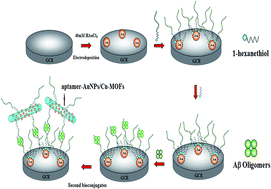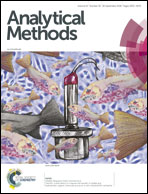A sensitive aptasensor for the detection of β-amyloid oligomers based on metal–organic frameworks as electrochemical signal probes†
Abstract
In this study, we developed a novel and facile electrochemical aptasensor for β-amyloid (Aβ) oligomer detection based on metal–organic frameworks (MOFs) as signal probes. By using an aptamer-tethered gold nanoflower (AuNF) modified electrode for target capture and aptamer-tagged gold nanoparticles/Cu-MOF (AuNPs/Cu-MOF) conjugates for sensitive signal generation, an effective sandwich sensor was obtained for the detection of Aβ oligomers. The unique physico-chemical properties of AuNPs/Cu-MOF conjugates, such as high electrochemical activity and large surface area, endow the sensor with excellent analytical performances. The designed aptasensor exhibits a wide linear range from 1 nM to 2 μM with a linear correlation coefficient of 0.996 and a relatively low detection limit of 0.45 nM for the detection of Aβ oligomers. For the evaluation of Aβ oligomers in artificial cerebrospinal fluid, the high recoveries and accuracy indicate the feasibility, which will provide valuable information for the early diagnosis of Alzheimer's disease. Moreover, the proposed electrochemical aptasensor based on multifunctional MOFs will provide a general strategy for sensing other analytes.



 Please wait while we load your content...
Please wait while we load your content...